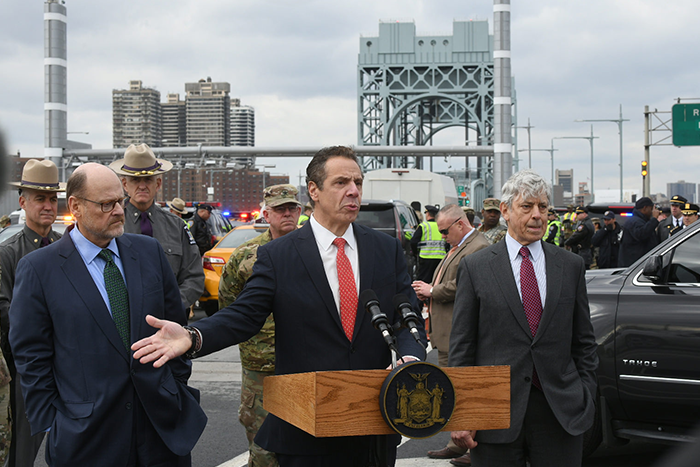Photos Courtesy of the Office
of the Governor and Riders Alliance
By Michael V. Cusenza
A State task force on Friday released its highly anticipated report that endorses a congestion-pricing plan to relax traffic bottlenecks on Midtown Manhattan streets and help subsidize the Metropolitan Transportation Authority’s overhaul of the city’s antiquated subway system.
And, predictably, not everyone is thrilled with the idea.
In October, Gov. Andrew Cuomo organized the Fix NYC Advisory Panel – a mix of community representatives, government officials, and business leaders from across the region tasked with developing recommendations to address the severe traffic congestion problems in Manhattan’s CBD and identify sources of revenue to fix the ailing subway system.
“The panel believes the MTA must first invest in public transportation alternatives and make improvements in the subway system before implementing a zone pricing plan to reduce congestion,” the group wrote in its 35-page report. “Before asking commuters to abandon their cars, we must first improve mass transit capacity and reliability.”
According to Fix NYC’s proposal, all drivers would be charged to enter the Central Business District – an area of Manhattan bounded by 60th Street on the north and Battery Park on the south, the Hudson River on the west and the East River on the east – during weekday business hours.
Car drivers would be charged $11.52; trucks, $25.34; cabs and app-based for-hire vehicles, $2 to $5 per ride. The revenue generated by such a tolling initiative would most likely exceed $1 billion annually.
“Implementing new fees and surcharges should always be viewed as a last resort, but the dire state of the NYC subway system demands action,” the panel wrote.
And what a dire state it is:
• Delays on the subway system have more than tripled in just five years. According to the MTA, on-time performance is down to less than 65 percent, the worst of any major transit system in the developed world.
• The MTA continues to make do with signal technology from the 1930s on most subway lines, and continues to run trains that have been in operation since the 1960s.
• Buses have become increasingly slow and unreliable, and people have started to abandon bus service—bus ridership dropped 16 percent between 2002 and 2015.
Cuomo said he will review and consider the group’s recommendations with the State Legislature over the next several months.
“The report accurately points out that the objective is not to raise tolls entering the borough of Manhattan, but more specifically those trips adding to the congestion in a defined central business district,” the governor said. “But, as a born and raised Queens boy, I have outer borough blood in my veins, and it is my priority that we keep costs down for hard-working New Yorkers, and encourage use of mass transit. We must also find a way to reduce the costs for outer borough bridges in any plan ultimately passed.”
On Sunday, Assemblyman David Weprin (D-Fresh Meadows), State Sen. Leroy Comrie (D-St. Albans), and City Councilman Barry Grodenchik (D-Oakland Gardens) led a rally in Manhattan near the Ed Koch Queensboro Bridge opposing the Fix NYC plan.
“New York’s middle class families and small businesses cannot afford congestion pricing in any form,” Weprin said.
That event was “crashed” by a demonstration led by the public transit advocacy group Riders Alliance.
“David Weprin is standing up for the few people who are rich enough to drive and park in Manhattan, and he is ignoring the needs of the vast number of working and middle-class New Yorkers who rely on the subway and buses,” said Rebecca Bailin, campaign manager for the Riders Alliance. “The congestion pricing plan outlined by the Fix NYC panel is a progressive way to fund urgent repairs to the transit system so that working people can get to their jobs, pick up their kids and keep their medical appointments. Today, we’re demanding that Assembly Member Weprin stop grandstanding at the expense of struggling New Yorkers and be part of the solution instead. Our elected officials represent millions of transit riders, and they’d better start acting like they care about our needs.”
Mayor Bill de Blasio has indicated that he is not in favor of a tolling plan, characterizing it as an issue of “fairness.”
“If people have to pay, are they getting something back for it? If people have to pay, does that money stay in New York City? These are the core questions,” de Blasio said on Wednesday on Fox 5’s “Good Day New York.” “Now, I believe the best way to solve the MTA crisis which is directly related is the millionaire’s tax. I believe taxing New York City millionaires and billionaires and using those proceeds to fix the MTA for the long term is the best and most reliable approach.”
Fix NYC noted that zone pricing “very effectively” reduced congestion, increased average speeds, spurred increased mass transit use, and improved air quality in London, Stockholm, and Singapore.
“To remain a world-class city and region, New York must address the increasing congestion on our roadways and bring the subway system back to a reliable state,” the panel concluded.

